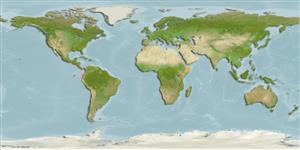>
Gobiiformes (Gobies) >
Gobiidae (Gobies) > Gobiinae
Etymology: Bathygobius: Greek, bathys = deep + Latin, gobius = gudgeon (Ref. 45335).
Eponymy: Édouard François André (1840–1911) was a French horticulturalist, landscape architect and designer, famously designing city parks in Monte Carlo and Montevideo before which he was part of the redesign of Paris open spaces. [...] (Ref. 128868), visit book page.
More on author: Sauvage.
Environment: milieu / climate zone / depth range / distribution range
Écologie
marin; saumâtre récifal. Tropical
Eastern Pacific: Costa Rica to the northern Peru.
Taille / Poids / Âge
Maturity: Lm ? range ? - ? cm
Max length : 15.3 cm TL mâle / non sexé; (Ref. 87607)
Occurs in both tidepools and sublittoral areas (Ref. 87607).
Life cycle and mating behavior
Maturité | Reproduction | Frai | Œufs | Fécondité | Larves
Thomson, D.A., 1987. Reef fishes of the Sea of Cortez. The rocky-shore fishes of the Gulf of California. The University of Arizona Press, Tucson. 302 p. (Ref. 5592)
Statut dans la liste rouge de l'IUCN (Ref. 130435: Version 2024-2)
Menace pour l'homme
Harmless
Utilisations par l'homme
Outils
Articles particuliers
Télécharger en XML
Sources Internet
Estimates based on models
Preferred temperature (Ref.
123201): 22.9 - 29.1, mean 26.9 °C (based on 224 cells).
Phylogenetic diversity index (Ref.
82804): PD
50 = 0.5000 [Uniqueness, from 0.5 = low to 2.0 = high].
Bayesian length-weight: a=0.00724 (0.00339 - 0.01546), b=3.10 (2.92 - 3.28), in cm total length, based on LWR estimates for this (Sub)family-body shape (Ref.
93245).
Niveau trophique (Ref.
69278): 3.6 ±0.6 se; based on size and trophs of closest relatives
Résilience (Ref.
120179): Haut, temps minimum de doublement de population inférieur à 15 mois (Preliminary K or Fecundity.).
Fishing Vulnerability (Ref.
59153): Low vulnerability (10 of 100).
Nutrients (Ref.
124155): Calcium = 103 [51, 193] mg/100g; Iron = 0.649 [0.329, 1.224] mg/100g; Protein = 18.4 [16.4, 20.1] %; Omega3 = 0.0869 [, ] g/100g; Selenium = 19.4 [8.9, 44.9] μg/100g; VitaminA = 114 [31, 374] μg/100g; Zinc = 1.99 [1.30, 2.93] mg/100g (wet weight);
